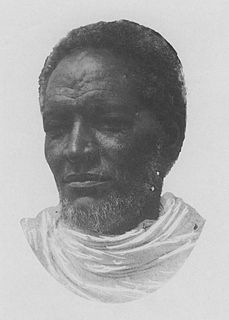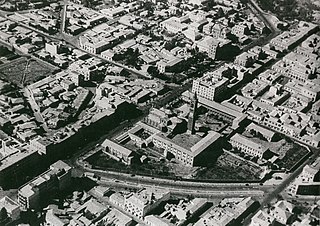 W
WThe Adal Sultanate, or Kingdom of Adal or Awdal, was a Muslim Somali kingdom and sultanate located in the Horn of Africa. It was founded by Sabr ad-Din II after the fall of the Sultanate of Ifat. The kingdom flourished from around 1415 to 1577. The sultanate and state were established by the local inhabitants of Zeila. At its height, the polity under Sultan Badlay controlled the territory stretching from western Somaliland to the port city of Suakin in Sudan. The Adal Empire maintained a robust commercial and political relationship with the Ottoman Empire.
 W
WThe Battle of Adwa was the climactic battle of the First Italo-Ethiopian War. The Ethiopian forces, who had high numerical superiority and weapons supplied by Russia and France, defeated the Italian invading force on Sunday 1 March 1896, near the town of Adwa. The decisive victory thwarted the campaign of the Kingdom of Italy to expand its colonial empire in the Horn of Africa. By the end of the 19th century, European powers had carved up almost all of Africa after the Berlin Conference; only Ethiopia, Liberia and the Dervish State still maintained their independence. Adwa became a pre-eminent symbol of pan-Africanism and secured Ethiopia's sovereignty until the Second Italo-Ethiopian War forty years later.
 W
WRas Alula Engida was an Ethiopian general and politician from Tigray. He was one of the important leaders of the Ethiopian Empire's forces during the 19th century. Described by Haggai Erlich as the greatest leader whom Abyssinia produced since the death of Emperor Tewodros II in 1868, Ras Alula was referred to by Europeans as "the Garibaldi of Abyssinia". He led many battles for the independence of Ethiopia, including Dogali and Adwa. In service of the Emperor Yohannes IV, Ras Allula successfully defeated the Egyptians in Gundet 1875, Gura 1876, Aylet 1887, Senhit 1880, against the mahdists of Sudan, Kufit 1885, Metema 1889 against Italians, Sahati 1887, Dogali 1887, Amba-Alaje 1889, Mekelle 1896 and Adwa 1896. When Yohannes returned from his unsuccessful campaign in Saati, he invaded and ravaged Gojjam for King Tekle Haymanot Tessema's rebellious intentions.
 W
WBahta Hagos was Dejazmach of Akkele Guzay, and retrospectively considered an important leader of Eritrean resistance to foreign domination specifically against northern Ethiopian and Italian colonialism. He was born into a rich peasant family, his father Hagos Andu of the Tsena-Degle from Akkele Guzay in the mid-19th century in the town of Segheneyti and was killed in the Battle of Halai against the Italian Colonial Army on December 19, 1894.
 W
WBanca per l’Africa Orientale (BAO) was an early attempt to establish modern banking in the Horn of Africa at a time when Eritrea and Italian Somaliland were Italian colonies. It closed in 1923.
 W
WThe Battle of Mekelle, sometimes known as the siege of Mekelle, took place in January 1896 during the First Italo-Ethiopian War. Italian forces surrendered a partially completed fort at Mekelle, a city in the northern Tigray Region of Ethiopia which they had occupied since 1895, to Ethiopian forces.
 W
WThe Eritrean People's Liberation Front (EPLF) or Shabia, was an armed Marxist-Leninist organization that fought for the independence of Eritrea from Ethiopia. It emerged in 1970 as an far left-wing group that split from the Eritrean Liberation Front (ELF). After achieving Eritrean independence in 1991, it transformed into the People's Front for Democracy and Justice (PFDJ), which serves as Eritrea's only legal political party.
 W
WThe tallero was the currency of Eritrea between 1890 and 1921. It was subdivided into 5 lire, each of 100 centesimi. The lira was equivalent to the Italian lira.
 W
WThe Ethiopian Civil War was a civil war in Ethiopia and present day Eritrea, fought between the Ethiopian military junta communist governments and Ethio-Eritrean anti-government rebels from September 1974 to June 1991.
 W
WAlfredo Guzzoni was an Italian military officer who served in both World War I and World War II.
 W
WHawulti is a pre-Aksumite or early Aksumite period obelisk located in Matara, Eritrea. The monument bears the oldest known example of the ancient Ge'ez script.
 W
WEritrea's capital of Asmara, 100km inland from its coast, has occupied a space in the highlands of Eritrea for hundreds of years. During the last century alone, it has been a staging ground for Italian initiatives in East Africa, collateral of Britain’s colonial politics, and victim of the expansion of Ethiopia’s empire until 1993 when it finally became the new and sovereign state of Eritrea. Only the large cluster of buildings built in the style of the Avant-Garde betrays the multifaceted history of this strange city and its urban core almost entirely unchanged for over seventy years.
 W
WItalian East Africa was an Italian colony in the Horn of Africa. It was formed in 1936 through the merger of Italian Somalia, Italian Eritrea, and the newly occupied Ethiopian Empire, conquered in the Second Italo-Ethiopian War.
 W
WItalian Eritrea was a colony of the Kingdom of Italy in the territory of present-day Eritrea. The first Italian establishment in the area was the purchase of Assab by the Rubattino Shipping Company in 1869, which came under government control in 1882. Occupation of Massawa in 1885 and the subsequent expansion of territory would gradually engulf the region and in 1889 borders with the Ethiopian Empire were defined in the Treaty of Wuchale. In 1890 the Colony of Eritrea was officially founded.
 W
W W
WThis article lists the colonial governors of Italian Eritrea from 1890 to 1941. They administered the territory on behalf of the Kingdom of Italy.
 W
WFrancesco de Martini was an Italian officer of the Military Information Service in Eritrea, when the Allies invaded Italian East Africa during World War II. He enlisted as a private in the Italian army in 1923, and left active service as brigadier general and the most decorated soldier of the Italian army during World War II.
 W
WMedri Bahri was a medieval Kingdom, also known to Ethiopians as Mareb Melash, it was situated in modern-day Eritrea and was ruled at times by the Bahri Negus and lasted from the 12th century to the Ethiopian occupation in 1879 and subsequent Italian colonization in 1889. It survived several threats like the invasion of Imam Gran and the Ottoman Red Sea expansion, albeit Medri Bahri irretrievably lost its access to the Red Sea due to the latter. The relation to the Ethiopian empire in the south varied from time to time, ranging from independence to tributary status to de facto annexation. At first the residence of the Bahr Negash was at Debarwa, but during the 17th century it was relocated to the village of Tsazega due to the same-named clan taking control of the kingdom.
 W
WThe National Museum of Eritrea is a national museum in Asmara, Eritrea. Established in 1992 by Woldeab Woldemariam, it was originally located in the former Governor's Palace until 1997, when it was moved. The venue has since been relocated to the former Comboni Sisters School for Women.
 W
WPostage stamps and postal history of Italian East Africa are related to the stamps and their history issued by the Kingdom of Italy between 1936 and 1941 for use in Italian East Africa, called in Italian Africa Orientale Italiana (A.O.I.). A.O.I. was made of Italian Eritrea, Ethiopia and Italian Somalia.
 W
WQohaito was a major ancient city in what is now the Debub region of Eritrea. It was a pre-Aksumite settlement that thrived during the Aksumite period. The city was located over 2,500 meters above sea level, on a high plateau at the edge of the Great Rift Valley. As of 2011, Qohaito's stone ruins have yet to be excavated. The ancient port city of Adulis is directly to the east, while Matara lies to the south.
 W
WThe Royal Corps Of Eritrean Colonial Troops were indigenous soldiers from Eritrea, who were enrolled as askaris in the Royal Corps of Colonial Troops of the Royal Italian Army during the period 1889–1941.
 W
WSembel is East Africa's oldest archaeological site in the Maekel Region of Eritrea and It dated back to as early as 800 BCE.
 W
WThe Sultanate of Dahlak was a small Medieval kingdom covering the Dahlak Archipelago and parts of the African Red Sea coast in what is now Eritrea. First attested in 1093, it quickly profited from its location between Abyssinia and Yemen as well as Egypt and India. After the mid 13th century Dahlak lost its trade monopoly and subsequently started to decline. Both the Ethiopian empire and Yemen tried to enforce their authority over the sultanate. It was eventually annexed by the Ottomans in 1557, who made it part of their Abyssinian province.